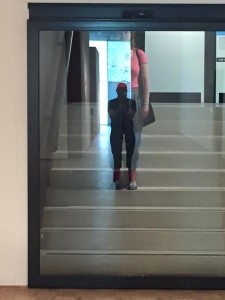#1: Kunsthal (general report)
We started to (individually) visit the shows at the Kunsthal. That took about 90 minutes. After that we gathered at the restaurant and discussed the experiences and possibilities. Every one of us came up with a personal concept and all were meant to be carried out by all three of us (as a group or seperately).
Not one of the concepts did actually respond to any aspect of the visited shows. They were related to the architectural qualities of the building, and mainly to a certain aspect of the building: the doors. We were not sure what this actually meant.
One of the possibilities is that doors are related to a performative aspect of a building: the moving around. And moving around in spaces was what we were doing and what we are basically interested in. It could also mean that we distanced ourself from the exhibitions. The show Do-it is mainly about performing of course, but this particular show was probably not the best presentation of Obrist’s concept. And maybe it just came too close and we could not distinguish ourselves enough from the work, needed to do this more radically by simply ignoring it.
The three different concepts focussed on doors as objects in their physical potentiality of letting people pass (Ieke Trinks), on the internal structure of the building in it’s relation to human displacement (Ienke Kastelein), and on the sliding doors as the location for approaching, encountering and passing others. Sliding doors play their own interactive role in this, seem to be the only part of the building that is aware of, and mechanically responds to it’s users. (Frans van Lent)
Sliding Door
A descending staircase ending in a sliding door. Behind the sliding door an exhibition space.
The first person goes down.
The sliding door opens, the person stops,
The door closes, the person turns around and goes up again.
This repeats a number of times till the person decides it is enough.
The person then walks on through the opened door.
(his place at the staircase will now be taken by a second person).
After going through the opened door the person walks a number of steps into the space.
The person then turns around and walks back towards the sliding door.
When it opens the person stops.
The door closes, the person walks backwards away from the door.
When the door opens the person stops again.
The door closes, the person starts walking forward towards the door.
This repeats a number of times till the person decides it is enough.
He leaves the scene. The second person now walks in through the opened door…
The only interactive moving part in the architecture is the sliding door. It opens and it closes when somebody approaches. The performer mirrors this action by walking forward and backward in response to the movements of the door and by that (indirectly) in response to the movements of the second performer and to other people entering or leaving the exhibition.
Photo: Ienke Kastelein


